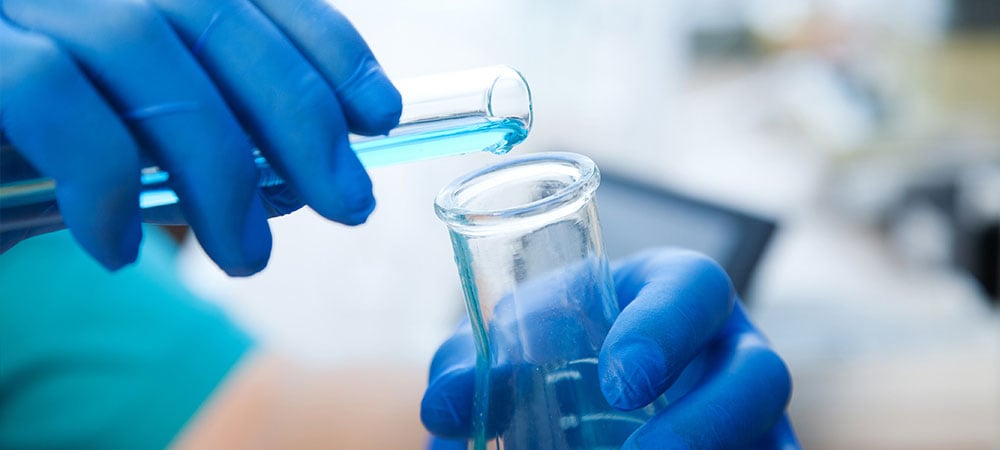
Perchlorate
November 2021
Summary
A component of rocket fuel, flares and fireworks, perchlorate occurs both naturally and as a synthetic chemical. EWG’s Tap Water Database includes records of perchlorate detected in 379 water utilities that serve an estimated 12 million people.
Perchlorate blocks the thyroid from taking in iodide, which is critical to the thyroid’s ability to regulate many body functions. Too little iodide can lead to an array of detrimental health problems, including reduced thyroid hormones and an impact on metabolism, and physical and cognitive development.
Children and the developing fetus are most at risk from perchlorate contamination, because their brains are still developing, and their bodies are highly sensitive to smaller fluctuations in iodide levels. Changes in thyroid hormone levels during pregnancy can have a lasting impact, since the thyroid system governs fetal brain development.
Massachusetts has the most health-protective drinking water regulation for the chemical in the country, at 2 parts per billion, or ppb. The presence of perchlorate in drinking water is also regulated in Arizona, California, New Jersey, New York and Texas. California set a public health goal of 1 ppb in 2015, although its legal limit remains 6 ppb. EWG recommends a Maximum Contaminant Level of no more than 2 ppb perchlorate in drinking water and, ideally, 1 ppb to protect children from the health harms caused by perchlorate.
In 2011, the Environmental Protection Agency determined that perchlorate met the Safe Drinking Water Act criteria for regulation, based on its potential health effects. However, in 2020 the agency withdrew the decision and announced it would not set a drinking water standard.
Click here to see nationwide test results for perchlorate.
Where is perchlorate found, and why is it in food and drinking water?
Perchlorate is very mobile in soil and groundwater, and does not readily degrade. These characteristics lead to the formation of underground pollution. High levels of contamination may be found near manufacturing facilitates, defense contracting sites and military operations. The defense and aerospace industries use 90 percent of domestically produced perchlorate.
EPA-mandated tests between 2001 and 2003 found perchlorate in drinking water systems serving more than 16.6 million people. These tests underestimated the extent of perchlorate pollution, because they did not include smaller water systems and those who drink well water.
New studies have highlighted the fact that perchlorate has also now contaminated irrigation water, fertilizer and food. Perchlorate is detectable in nearly all produce, dairy products and packaged foods – the sources of an estimated 80 percent of Americans' exposure.
What can I do if there is perchlorate in my water?
If perchlorate is detected in your water, select a home water filter that uses reverse osmosis to reduce the level of contamination. You can find EWG’s water filter guide here.
Make sure any system you purchase is certified to remove perchlorate. If you have perchlorate in your drinking water and are pregnant or breastfeeding, or have young children at home, it is best during this critical period of sensitivity to drink filtered water only.
References
California Office of Environmental Health Hazard Assessment, Updated Public Health Goal for Drinking Water: Perchlorate. 2015. Available at oehha.ca.gov/media/downloads/water/chemicals/perchloratephgfactsheet_0.pdf
Environmental Defense Fund. FDA Finds More Perchlorate in More Food, Especially Bologna, Salami and Rice Cereal. 2017. Available at blogs.edf.org/health/2017/01/09/fda-finds-more-perchlorate-in-more-food/
Environmental Defense Fund, EPA to Consider Perchlorate Risks from Degradation of Hypochlorite Bleach. 2017. Available at blogs.edf.org/health/2017/02/03/perchlorate-risks-from-bleach/
Philip Brandhuber et al. A Review of Perchlorate Occurrence in Public Drinking Water Systems. Journal AWWA, 2009, 101;11. Available at www.epa.gov/sites/production/files/2015-09/documents/12004-exhibita.pdf
Environmental Protection Agency. Fact Sheet: Final Regulatory Determination for Perchlorate. 2011. Available at www.epa.gov/sites/production/files/2015-08/documents/epa815f11003.pdf
EPA, Technical Fact Sheet – Perchlorate. 2014. Available at www.epa.gov/sites/production/files/2014-03/documents/ffrrofactsheet_contaminant_perchlorate_january2014_final.pdf
EPA, Consent Decree. 2016. Available at blogs.edf.org/health/files/2016/12/Perchlorate-NRDC-v-EPA-2-16-cv-01251-ER-Consent-Decree-Entered-10-19-16.pdf
Food and Drug Administration. Preliminary Estimation of Perchlorate Dietary Exposure Based on FDA 2004/2005 Exploratory Data. 2007. Available at www.fda.gov/Food/FoodborneIllnessContaminants/ChemicalContaminants/ucm077653.htm
FDA, Perchlorate Questions and Answers. 2015. Available at www.fda.gov/Food/FoodborneIllnessContaminants/ChemicalContaminants/ucm077572.htm#epahealth
Massachusetts Department of Environmental Protection, 310 CMR 22.06 Inorganic Maximum Contaminant Levels (MCLs). 2016. Available at www.mass.gov/eea/docs/dep/water/laws/i-thru-z/perchlorate-310cmr22-07282006.pdf
